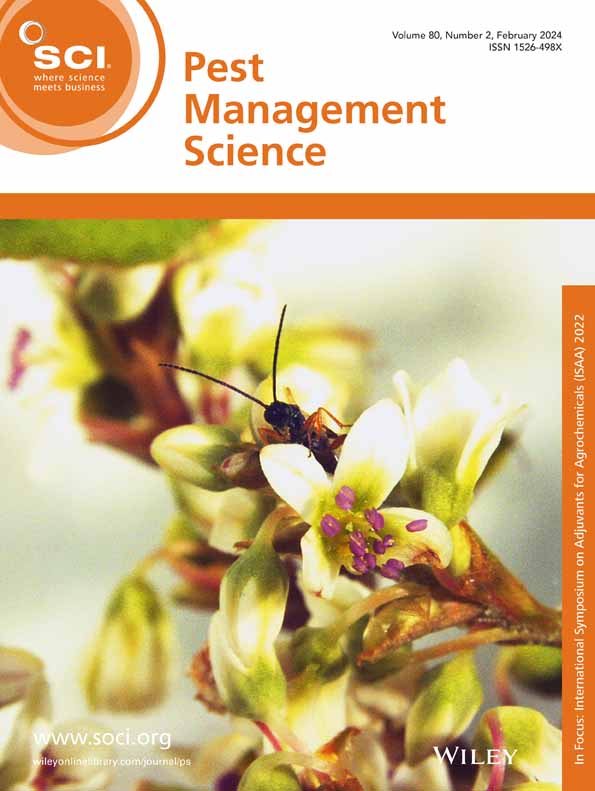皂子果皮提取物的抗真菌活性:一种有效的植物病原真菌防治方法。
IF 3.8
1区 农林科学
Q1 AGRONOMY
引用次数: 0
摘要
木刺木(dsapindus mukorossi)是一种应用于生物质能、生物技术和园林绿化的多功能木本植物。主要目的是评估皂子果皮提取物对几种常见植物病原真菌的抗真菌潜力。结果皂子果皮提取物对6种植物病原菌均有广谱的抗真菌活性。对大丽花黄萎病菌和尖孢镰刀菌的孢子萌发有较好的抑制作用。在随后的大丽花弧菌接种试验中,与对照相比,皂子提取物显著降低了棉花黄萎病的发病率。此外,经提取液处理的棉花在感染大丽花弧菌后,抗病基因PR1和PR5的表达上调幅度更高。提取物还显示出潜在的促进生长的作用。在水果生物防治试验中,该菌株对番茄番茄灰霉菌具有显著的抗真菌活性,可防止接种部位菌丝体扩张,将柑橘的指状青霉侵染率降低至13%,而对照为85%。提取实验进一步证实了以水为溶剂提取皂子果皮中抗真菌活性成分是最有效、最经济的方法。结论皂子果皮提取物具有显著的广谱抗真菌活性,在植物病害管理和果实生物防治方面具有广阔的应用前景。所确定的水提取方法为利用这些有益的抗真菌成分提供了一种有效和经济的方法。©2025化学工业协会。本文章由计算机程序翻译,如有差异,请以英文原文为准。
Antifungal activity of soapberry pericarp extracts: an effective approach against plant pathogenic fungi.
BACKGROUND
Sapindus mukorossi, a versatile woody plant utilized in biomass energy, biotechnology and landscaping, has been the focus of this study. The primary objective was to assess the antifungal potential of soapberry pericarp extracts against several common plant pathogenic fungi.
RESULTS
The investigation revealed that the soapberry pericarp extract displayed broad-spectrum antifungal activity against six plant pathogenic fungi. Notably, it effectively inhibited the spore germination of Verticillium dahliae and Fusarium oxysporum. In subsequent inoculation trials with V. dahliae, the soapberry extract significantly reduced the incidence of cotton verticillium wilt compared to the control. Additionally, cotton treated with the extract showed a higher upregulation of disease-resistance genes PR1 and PR5 postinfection with V. dahliae. The extract also suggested a potential growth-promoting effect. In fruit biocontrol assays, it demonstrated remarkable antifungal activity against Botryitis cinerea in tomato, preventing mycelial expansion at the inoculation site, and reduced Penicillium digitatum infection in citrus to merely 13%, in contrast to 85% in the control. Extraction experiments further confirmed that using water as the solvent was the most efficient and economical method for extracting antifungal active components from soapberry pericarp.
CONCLUSION
The study concluded that soapberry pericarp extracts possess significant broad-spectrum antifungal properties, showing promise as a potential alternative for plant disease management and fruit biocontrol. The water extraction method identified offers an effective and cost-effective way to harness these beneficial antifungal components. © 2025 Society of Chemical Industry.
求助全文
通过发布文献求助,成功后即可免费获取论文全文。
去求助
来源期刊

Pest Management Science
农林科学-昆虫学
CiteScore
7.90
自引率
9.80%
发文量
553
审稿时长
4.8 months
期刊介绍:
Pest Management Science is the international journal of research and development in crop protection and pest control. Since its launch in 1970, the journal has become the premier forum for papers on the discovery, application, and impact on the environment of products and strategies designed for pest management.
Published for SCI by John Wiley & Sons Ltd.
 求助内容:
求助内容: 应助结果提醒方式:
应助结果提醒方式:


